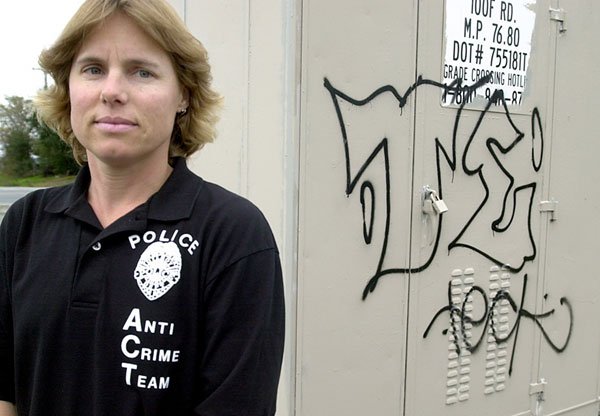GILROY
– When the going got tough, Gilroy’s City Council got tougher,
and the results are clear.
Facing what was seen by many as a graffiti epidemic of chronic
proportions, Gilroy’s City Council and police department formed
a
”
zero-tolerance
”
policy on graffiti perpetrators four years ago, and the city
hasn’t looked the same since.
GILROY – When the going got tough, Gilroy’s City Council got tougher, and the results are clear.
Facing what was seen by many as a graffiti epidemic of chronic proportions, Gilroy’s City Council and police department formed a “zero-tolerance” policy on graffiti perpetrators four years ago, and the city hasn’t looked the same since.
“At one point, there was so much graffiti we didn’t know where to start,” said Cherie Somavia, the Gilroy Police Department’s juvenile intervention officer for the last three years who handles the majority of the department’s graffiti investigations. “But because of the zero-tolerance policy and the support from the city and the community, we now have many good avenues to curb graffiti and everyone can see the difference.”
Since the city began cracking down on graffiti “art,” Gilroy has seen a dramatic decline in the amount of spray paint “tags” and markings on its private and public property, according to several members of the police department and city government.
Somavia used to regularly have 12 to 15 Gilroy kids – usually males between the ages of 12 and 16 – on her probation check list for graffiti-related vandalism. Now she usually has six to eight. The number of calls to report graffiti have also declined by almost 70 percent.
Last year, graffiti vandals caused more than $25,000 worth of damage in the city – Somavia estimates that figure is less than half of the annual graffiti damage registered in Gilroy throughout the mid- and late-1990s.
“We don’t have total control now, but I would say it’s down 90 percent,” said City Councilman Charlie Morales, who has been a county juvenile probation worker for the last 35 years. “Working with youngsters for so long, I can say that graffiti is the first sign in gang and criminal activity. This is why it was so important for the city to become proactive and suppress this problem.”
Under the city’s zero-tolerance graffiti policy, any youth arrested for first-time graffiti activity must serve 66 hours of community service, go through a restorative justice program and mandatory counseling. Penalties for a second violation include 130 hours of community service, formal probation and possible jail time.
In years past, youth caught for graffiti activity in the city would often go unpunished or receive only a small amount of community service.
“It’s important to let them know that we take this seriously,” Somavia said. “They learn early that this is not a light crime. Graffiti hurts the pride of the entire community and costs a lot of money.”
Just as important a deterrent as the stiffened penalties is a city policy to abate or cover up new graffiti in a timely manner, Somavia said.
The city ordinance on graffiti states that reported graffiti must be removed within 48 hours of its appearance, but thanks to community support, it’s usually gone in 24 hours.
During the years of Gilroy’s peak gang activity graffiti was often used as a way to mark territory, but now “80 percent” of Gilroy’s graffiti is non-gang related, Somavia said.
“The kids doing graffiti now are looking for fame,” said Sandra Sammut, a GPD community service officer and coordinator of the city’s $20,000-a-year anti-graffiti program. “If you paint over the graffiti quickly, they don’t get that fame – their name or tag is gone. After four or five times of getting their tags painted over, they will get frustrated and give up.”
In an effort to keep “taggers” frustrated, Sammut works closely with two part-time CSO officers to chart graffiti around the city and work with citizens calling the city’s graffiti hotline.
“When we first started the hotline four years ago, we would have six or seven calls a day,” Sammut said. “Now we have that many in a week because there’s not as much to report.”
Typically when graffiti is reported, the police will offer the victims supplies such as paint, brushes and rollers to repaint the area hit. In some situations, the police will also offer to provide the labor through “Wipeout Watch,” a group comprised of citizens who volunteer their time to clean graffiti.
“The citizens in this group are so great,” Sammut said. “But it’s not just them, the whole community has made our anti-graffiti program work. Without the calls from citizens, we couldn’t do our job – there’s no way we can monitor the whole city on our own.”
But Sue Baker doesn’t see it as charity, she sees it as necessity.
A member of Wipeout Watch since it was informally started more than a decade ago by concerned citizens Al Gagliarodi and the late Tom Carr, Baker said she takes it personal when she sees graffiti in her neighborhood.
“Graffiti is ugly and rude,” said Baker, who scans her Gilroy High School neighborhood for new graffiti each morning when she takes her dog for a walk and often returns in the evening to paint over it. “It’s a matter of pride. If we don’t take care of our own community, who will? It’s gotten a lot better in the city, but we can always improve.”
To report graffiti call the city’s graffiti hotline at 846-0395. To volunteer for graffiti cleanup with Wipeout Watch, call Sandra Sammut at 846-6572.













